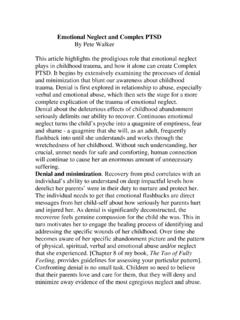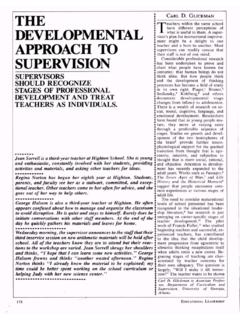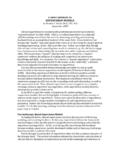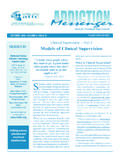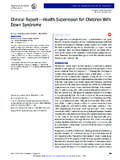Transcription of Parallel Process in Relational Supervision - Pete …
1 Parallel Process in Relational Supervision By Pete Walker, 925 283-4575 This eclectic article on Supervision incorporates psychodynamic principles that derive from a Relational or Intersubjective perspective. It encourages the supervisor to model a healthy, therapeutic style of relating for supervisees to introject and use with their clients. Potent Parallel processes will be illustrated here that can transfer beneficially from the supervisory relationship to the trainee-client relationship. The judicious use of Parallel Process offers supervisors a uniquely effective way to experientially pass on their wisdom and accomplishment to their trainees. Parallel Process is a subset of the psychodynamic principle of repetition compulsion. It refers to the fact that various dynamics of the supervisor/supervisee relationship are commonly reenacted in the intern's relationship with her client, and sometimes - by further extension - in the client s relationships with her children and significant others.
2 In best case scenarios this highly enhances the therapeutic work of the intern. In worst case scenarios, counter-therapeutic dynamics with the supervisor are reenacted by the trainee with her clients. Paraphrased in the vernacular, and invoking what we know about child development: children [and trainees] do what we do, not necessarily what we say. Modeling is a key mechanism in Parallel Process , and it can be helpful or hindering. One common example of the latter - endemic to traditional supervisory approaches that overemphasize the teaching aspect of Supervision - occurs when the supervisor spouts forth authoritatively and dogmatically, and encourages and produces the same stance in his supervisee. Such Supervision models and risks teaching an over-didactic style - a stance of over-directing and saying too much, too often, too authoritatively - a stance that many supervisees are already hazardously prone to. A pedantic and authoritative supervisory style too easily reinforces the typical trainee s stubborn penchant for micromanaging the client.
3 While the Relational approach that I employ and advocate has plenty of room for teaching, it also cultivates in a moderate and clearly boundaried way, the "treat" or therapeutic side of relating. This approach typically involves a balanced blending of instructing and treating that eclectically resolves what Joan Sarnat describes as the teach/treat controversy in Supervision [see her excellent book: The Supervisory Relationship]. Even better, the intersubjective approach often teaches and treats at the same time, as modeling often serves as a form of teaching behaviorally. I believe the treat dimension of Supervision is especially important for the many interns who suffer from untreated attachment disorders, and who have consequently never had a substantially safe relationship. If the trainee has never had effective therapy [which in my experience is typical], his capacity to be vulnerable in relationship often remains developmentally arrested; this in turn customarily obviates his ability to explore his deepest, most vulnerable concerns in Supervision , or anywhere else for that matter.
4 While I am, by no means, advocating an extensive provision of the unmet need to experience safe vulnerability, I have offered many of my supervisees enough of a taste of this kind of relating that it has been relatively easy over time to steer them into their own therapy to more thoroughly address this handicapping developmental arrest. In the service of creating a Parallel Process that helps supervisees - and by extension - clients work through their attachment issues, intersubjective Supervision models to the trainee a healthy and efficacious way of interacting with the client, a Process that in itself is therapeutic. In this regard, Relational Supervision values and proceeds by fostering the essential qualities of healthy relationship, such as empathy, respectful mutuality, vulnerability, emotional authenticity, and collaborative rapport repair. Without these qualities, trust does not develop in human relationships. These qualities foster the sense of safety that both supervisees and clients need to feel supported enough to bring up their most important [and typically most vulnerable] struggles and concerns.
5 Without enough experience of being safely held, trainees commonly withhold vulnerable concerns via a fear of being attacked, shamed and/or abandoned in ways that replicate the behaviors of the original caregivers who created their attachment disorders in the first place. Let us look more extensively at developing the qualities of safe relationship, and by extension specific Parallel processes to enhance Supervision . I often hope that the merits of establishing empathy as a Parallel Process is a given, but I have sadly heard [and personally experienced in my own training] too many stories of empathy-impoverished Supervision . In this regard I will simply say here that if we are hard and unsympathetic with our supervisees, we risk them imitating our sternness with their clients. Respectful mutuality is somewhat self-descriptive. It is cultivated with dialogical relating, and values the importance of fully eliciting the other so that we may comprehensively understand his circumstances, and subsequently help him more effectively.
6 In this regard, respectful mutuality implies a supervisee-centered and client-centered matrix of Supervision and therapy respectively. My allegiance to the client-centered position derives partially from a mistake I repeatedly made as a young therapist. All too often, I took charge and began sessions with what the client left off with last week; and all too often compliance with my directives led the client to bypass new issues that had since become much more crucial concerns. With one particular client, I realized much too late that last week s musings about her divorce paled compared to the fact that yesterday her borderline mother moved into her house unannounced. As a young supervisor, I had to learn a Parallel lesson with my supervisees. In another instance, my over-directing curiosity about my trainee's last session with his most difficult client, used up so much time that he barely got to his key concern - a not-so-veiled suicide threat by his newest client.
7 Respectful mutuality is fostered by promoting a teamwork approach to the Supervision - by inviting the supervisee to work with us cooperatively to set the agenda of the Supervision - just as we hope she will do with her clients. Respectful mutuality is further enhanced by a brainstorming approach to the understanding and the treatment of the client s issues, and except in cases where we do have to be pedantic about legal and ethical issues, is enhanced by something akin to a take-it-or-leave-it approach to giving advice. Respectful mutuality honors the fact that we often do not have as full a gestalt of the client as the supervisee, who has so much more face-to-face, psyce-to-psyche experience of the client. In terms of Parallel Process , it not only cultivates a client-centered approach in the trainee, but also ongoingly develops the trainee s capacity for empathic attunement. Moreover it empowers the supervisee in a way that behaviorally teaches her to support the growth and development of the client's own coping skills and sense of empowerment.
8 The judicious and sparing use of vulnerabilty and emotional authenticity [an especially important form of vulnerability] is another important Parallel Process that can potentiate Supervision . I came to value this the hard way via not getting much out of my own first experiences in therapy, because my therapists were of the old, blank screen school - distant, removed and seemingly holding themselves as paragons of perfection and mental health. Therapy was actually counter-therapeutic for me until I began to understand the nature of my own unresolved attachment issues, and sought out and found a Relational therapist who valued the use of her own vulnerable and emotionally authentic self as a tool in the therapy. Her temperate and timely disclosures that universal existential issues still occasionally troubled her [ God, the holidays can be awful; Sorry, I think I'm running a little anxiety about my dental appointment later today; ] helped me to deconstruct the defensive structure I unconsciously built as a child to hide my pain.
9 Her modeling that anger, sadness, fear, and depression were emotions that could be healthily felt and expressed rather than buried in shame and gotten over helped me to renounce the emotional perfectionism that I adopted in childhood in the hope of being loved. I needed this kind of modeling, as so many of my clients and supervisees have, to begin to emerge from my fear of being attacked, shamed and abandoned for having dysphoric feelings - as well as troubling thoughts and imperfect behaviors. In order to let go of my Sisyphean salvation fantasy of achieving perfection, I needed to experience that all the less than shiny bits of me were acceptable to another human being. Just as the therapist s judicious use of vulnerable self-disclosure helps the client move out of the shame-lined slippery pit of perfectionism, the supervisor can use her vulnerability to help deconstruct the hamstringing perfectionism that plagues and stultifies so many beginning therapists.
10 Here are some examples of authentic and vulnerable self-disclosures I have offered to various supervisees: "First sessions with new clients still sometimes trigger my fear; "When I'm temporarily confused and don't know what to say or do, ; "When I'm not feeling genuinely empathic with the client, ; "I feel really sad about what happened to your client;" "These inveterate domestic violence cases sometimes make me feel depressed;" " I feel really angry that she got stuck with such a god-awful family." "When my inner critic is overreacting to a mistake I think I made in session, I remind myself of the Winnicottian concept that I only have to be a good enough therapist;'" My most consistent feedback from past supervisees is that responses like these - especially ones that normalized the recurring fear that is naturally endemic to the therapist position - helped them immeasurably to deconstruct their unrealistic perfectionistic expectations of themselves.
